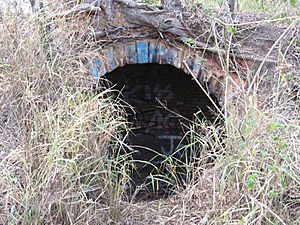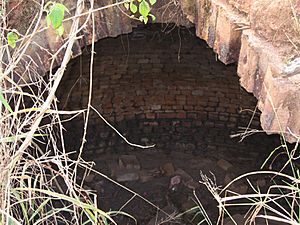Klondyke Coke Ovens facts for kids
Quick facts for kids Klondyke Coke Ovens |
|
|---|---|

Klondyke Coke Oven with graffiti inside, 2007
|
|
| Location | Parker Lane, Brassall, City of Ipswich, Queensland, Australia |
| Official name: Klondyke Coke Ovens, Klondyke Beehive Coke Ovens, Klondyke Coking Ovens | |
| Type | state heritage (archaeological) |
| Designated | 3 December 2007 |
| Reference no. | 602566 |
| Significant period | 1940s (fabric) 1940s-1950s (historical use) |
| Significant components | kiln, railway siding, mullock heap, coke oven, oven, wall/s - retaining |
| Lua error in Module:Location_map at line 420: attempt to index field 'wikibase' (a nil value). | |
The Klondyke Coke Ovens are historic ovens located at Parker Lane, Brassall, City of Ipswich, Queensland, Australia. These ovens are also known as Klondyke Beehive Coke Ovens or Klondyke Coking Ovens. They are special because they are a type of beehive oven used to make coke from coal. The ovens were added to the Queensland Heritage Register on 3 December 2007, meaning they are protected for their historical importance.
Contents
Discovering the Klondyke Coke Ovens
The Klondyke Coke Ovens were built in the 1940s. They were part of the Klondyke Colliery, which was a coal mine in Brassall. Even though these ovens were built later, coke production at this site actually started much earlier, in the 1880s.
The site had two main periods when coke was made. It also changed owners and names several times. The last change happened in 1948. Production stopped in the early 1950s because there wasn't much coal left to mine. Since then, the ovens have been unused and are now covered by plants.
Early Coal Mining in Queensland
Coal was first found in Queensland in 1825 by Major Edmund Lockyer. He saw it near the Brisbane River. A few years later, when Ipswich was settled, Captain Patrick Logan also noticed coal between Ipswich and Brisbane. Explorer Allan Cunningham marked coal spots on the Bremer River on his map.
Coal became one of the first minerals mined for business in Queensland. Mining began in Goodna in 1843. The West Moreton Coalfield in Ipswich started in the early 1850s. At first, Queensland's coal wasn't as good as coal from Newcastle. But as Queensland grew, more coal was needed for trains and factories.
Coal and Railways
There was a strong connection between Queensland Government Railways and the coal industry. The railways needed a lot of coal to run their trains. This made them the biggest customer for coal mines. At the same time, coal mines needed railways to transport their coal. A mine couldn't make money unless it was connected to the rail network. So, the growth of coal mining in Queensland was closely tied to the railway system.
What is Coke?
Coke is a special type of fuel made from coal. It's also used to help melt iron ore. Coke is made by baking a type of coal called bituminous coal in ovens. The ovens get very hot, up to 2,000 degrees Fahrenheit (about 1,100 degrees Celsius). Making coke was often seen as a smaller part of coal mining. There weren't many rules about it, so not many early records were kept.
How Beehive Ovens Work
The coke ovens in the West Moreton Coalfield were all "beehive" type ovens. They got their name because they looked like beehives with their domed shape. Each beehive oven was a brick dome. It had a small hole at the top for smoke to escape. There was also a larger arched opening on one side. This opening was used to put coal in and take coke out.
These ovens were usually built in two rows, called "batteries." The space between the ovens was filled with rocks and earth. This helped keep the heat inside. A stone wall often surrounded the whole battery. This wall helped hold the brick domes in place. The Klondyke ovens could make about four to five tons of coke at a time.
To make coke, coal was shoveled into an empty oven. It was piled about 0.6 meters (2 feet) high and then lit. The oven door was then sealed with bricks or an iron plate. A small hole was left to let in a little air. The top layer of coal would burn. This process would release gases from the coal. The dome of the oven would get very hot. This heat helped turn the coal into coke. The whole process took about three days.
Once the coke was ready, water was sprayed into the oven to cool it down. Workers would then use rakes to pull the coke out. It took almost two tons of coal to make one ton of coke.
Why Old Technology Was Used
Beehive coke ovens were common for many years. However, by the early 1900s, newer and better ways to make coke were invented. These new methods could even use the by-products (leftovers) from coke production. But these new technologies were more expensive.
Despite this, beehive coke ovens continued to be built in the Ipswich coal fields until the mid-1900s. There are a few reasons why this might have happened:
- The simpler beehive ovens were cheaper to build and operate.
- They might have been good enough for the amount of coke needed in Ipswich.
- During World War II, it was hard to get materials and workers. Beehive ovens were cheap to build, used bricks that were easy to find, and didn't need many workers.
- Some coal pits might not have had enough coal left to make it worth investing in expensive new coke-making methods.
The Klondyke Colliery Story
The Klondyke Colliery was one of many coal mines in the West Moreton Coalfield in Ipswich. It was one of the longest-running mines. The first mine on this site, in 1871, was called Eastwood mine. It was named after its owner, John Eastwood. This mine operated until 1877. Then, it was left unused for several years.
In 1884, the site was sold to Brydon, Jones & Company. They renamed it Mihi mine. This is when the first beehive coke ovens were built on the site. These ovens were used until 1891. The site was mined again in 1908 by Paul Francis. In 1923, Francis sold the site. A group of miners and a lawyer formed a company called Klondyke Collieries Limited.
Under Klondyke Collieries Limited, coke production grew. In 1942, several new coke ovens were built at Klondyke. This was to meet the high demand for coke used in melting metals. In 1945 and 1946, Klondyke and Bowen (in northern Queensland) were the only places making coke in Queensland. Klondyke produced about one-sixth of Queensland's coke.
In 1948, the site changed hands again and was renamed Moreton colliery. It operated until the early 1950s, when the coal supply ran out. After Klondyke closed, the nearby Haighmoor site took over coke production. It continued for another 15 years as Queensland's only coke works besides Bowen.
The bricks used to build the ovens have a large "R" mark on them. These bricks likely came from the Rylance Colliery, a local brickworks. Rylance Colliery started in the 1880s and added a brickworks in 1931.
Today, the land where the ovens stand is owned by the Department of Natural Resources and Mines. Since production stopped in the 1950s, the ovens have fallen apart. They are covered in plants and have been damaged by people.
What the Klondyke Coke Ovens Look Like Today
The Klondyke Coke Ovens are in Brassall. You can find them by walking from the corner of W.M. Hughes and Musgrave Streets. Walk down the hill and follow the path to the right for about 200 meters (650 feet). The path splits. Take the left (upper) path to reach the ovens. The right (lower) path goes past a brick retaining wall.
The ovens are built into the side of a hill, above Mihi Creek. They are north of the nearby North Ipswich Railway Workshop area. The ovens form a large mound covered in earth. This mound is about 23 meters (75 feet) long, 6 meters (20 feet) wide, and 2 to 3 meters (6.5 to 10 feet) high. It's heavily covered with plants and leaves, so it's hard to see until you are very close.
There are twelve ovens in total. They are arranged in two rows, with six ovens in each row, back to back. They have a domed shape. Each oven is about 3.45 meters (11 feet) across and 1.65 meters (5.4 feet) high. The ovens are made of brick and each has its own flue (a channel for smoke). Some of the ovens have collapsed, and two are completely caved in. People have also removed bricks to make fireplaces, and there is graffiti on the ovens.
You can see the rubble that was used to fill the space between the ovens in some places. It's a mix of bricks and different sized rocks.
On the side facing Mihi Creek, there's a brick wall. It's about 5 meters (16 feet) long and 2 to 3 meters (6.5 to 10 feet) high. This wall marks a drop from the oven mound to a flat area below. This wall also has a lot of graffiti.
Around the site, you can find pieces of brick, coal, and coke. There are also metal parts from old machinery. These include parts of skips (small carts), railway lines, crushing machines, and conveyor buckets.
The bricks used to build the ovens have a large "R" in the middle.
Why the Klondyke Coke Ovens Are Important
The Klondyke Coke Ovens were added to the Queensland Heritage Register on 3 December 2007. This means they are recognized as an important part of Queensland's history and culture.
Showing Queensland's History
The Klondyke Coke Ovens are a great example of how coke was made in Queensland. In the 1940s, they were one of only two places producing coke in Queensland. They show how the coal mining industry grew and played a big role in Queensland's past.
A Rare Part of History
These ovens are special because they show a way of making coke that is now uncommon. While beehive ovens were once very common, new technology has replaced them. The Klondyke ovens are still quite complete, making them a rare example of this old process.
Learning from the Past
As an old industrial site, the Klondyke Coke Ovens can teach us a lot. They are still mostly intact. Studying them can help us understand Queensland's industrial history better. They can also be compared to other similar sites to learn even more.
A Great Example of Their Kind
The Klondyke Coke Ovens are a typical example of coking ovens from the 19th and mid-20th centuries. They show all the main features of beehive coke ovens. They are dome-shaped, have individual flues, and are built in back-to-back rows.


